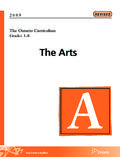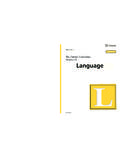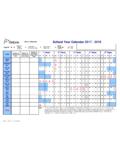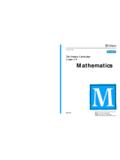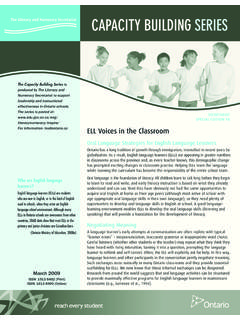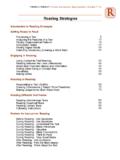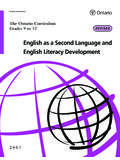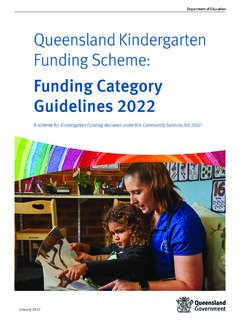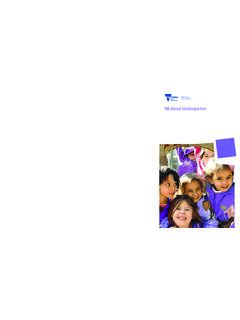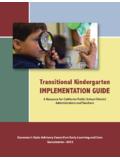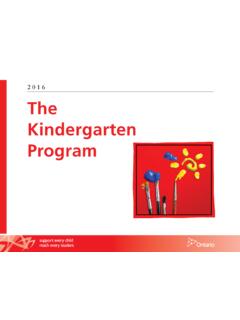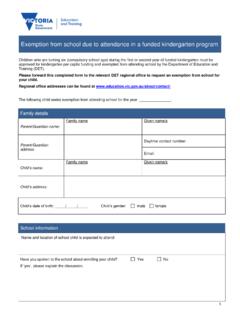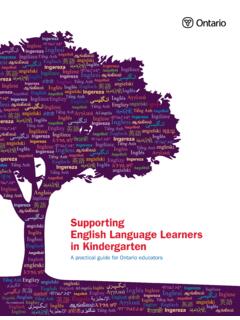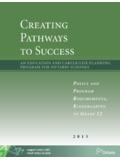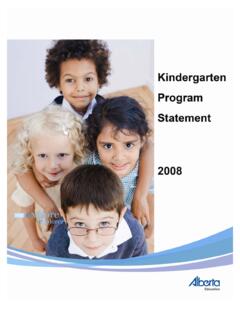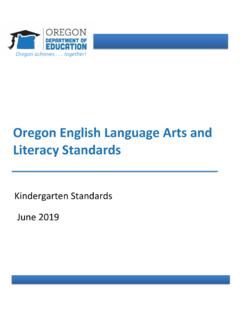Transcription of The Ontario Curriculum Grades 1-8 and The Kindergarten …
1 Resource Guide The Ontario Curriculum Grades 1-8. and The Kindergarten Program First Nations, M tis, and Inuit Connections Scope and Sequence of Expectations 2016. Contents PREFACE .. 3. THE Kindergarten PROGRAM ..7. GRADE 1 .. 10. GRADE 2 .. 14. GRADE 3 .. 20. GRADE 4 .. 29. GRADE 5 .. 41. GRADE 6 .. 52. GRADE 7 .. 66. GRADE 8 .. 81. The Ontario Public Service endeavours to demonstrate leadership with respect to accessibility in Ontario . Our goal is to ensure that Ontario government services, products, and facilities are accessible to all our employees and to all members of the public we serve. This document, or the information that it contains, is available, on request, in alternative formats. Please forward all requests for alternative formats to Service Ontario at 1-800-668-9938 (TTY: 1 0-268-7095). Une publication quivalente est disponible en fran ais sous le titre suivant : Le Curriculum de l' Ontario de la 1re la 8e ann e Perspectives des Premi res Nations, des M tis et des Inuits : Port e et encha nement des attentes et contenus d'apprentissage, 2016.
2 This publication is available only on the Ministry of Education's website, at 2. PREFACE. Over the past three years, relationships with school boards; schools; parents; teachers; and First Nation, M tis and Inuit communities and organizations have become stronger. Activities have enhanced targeted supports for students and educators. Knowledge and awareness of First Nation, M tis and Inuit histories, cultures and perspectives have increased throughout the provincial education system. Through additional supports, including classroom resources and professional development opportunities, teachers are also better equipped to embed Aboriginal perspectives into the classroom.. Ontario Ministry of Education, A Solid Foundation: Second Progress Report on the Implementation of the Ontario First Nation, M tis, and Inuit Education Policy Framework, 2013, pp. 6 7. In support of its focus on student achievement and closing attainment gaps, the Ministry of Education has identified First Nations, M tis, and Inuit education as an important priority in Ontario .
3 Ministry policies, strategies, and initiatives, including the equity and inclusive education strategy, the English language learners policy, and the Indigenous education strategy, support respect for and acceptance of diversity in Ontario 's schools. For example, through the Ontario First Nation, M tis, and Inuit Education Policy Framework, a key part of the Indigenous education strategy, the ministry is committed to developing strategies to support and strengthen a Curriculum that facilitates learning about contemporary and traditional First Nations, M tis, and Inuit cultures, histories, and perspectives among all students. To ensure that Indigenous perspectives are represented in the Curriculum , a wide range of Indigenous partners, including First Nations, M tis, and Inuit Elders, Senators, knowledge keepers, educators, cultural advisers, and community leaders, are engaged in the Curriculum review process. All revised Curriculum policy documents also undergo a third-party review to ensure the accuracy and relevancy of the First Nations, M tis, and Inuit perspectives included in them.
4 Ontario publicly funded schools have an important role to play in promoting an inclusive school climate and a learning environment in which all students, including First Nations, M tis, and Inuit students, see themselves reflected in the Curriculum and in which all students have opportunities, across the Ontario Curriculum , to learn about and appreciate contemporary and traditional First Nations, M tis, and Inuit cultures, histories, and perspectives. The Ontario Curriculum promotes active and engaged citizenship, which includes greater awareness of the distinct place and role of Indigenous peoples in our shared heritage and in the future of Ontario . As the following statement by Clinton L. Beckford and Russell Nahdee indicates, the inclusion of First Nations, M tis, and Inuit connections in the Curriculum creates enriching experiences and outcomes for all learners: 3. For Aboriginal students, the inclusion of indigenous perspectives can help to foster engagement in the learning process through increased relevance to their own experiences and culture, leading to increased self-esteem and better learning outcomes.
5 For other students, indigenous perspectives extend and enrich the educational experience, provide intercultural knowledge and experiences and afford opportunities to explore and appreciate Aboriginal socio-cultural, economic and ecological contributions to Canadian society.. Teaching for Ecological Sustainability: Incorporating Indigenous Philosophies and Practices , What Works? Research into Practice, Research Monograph #36 (Literacy and Numeracy Secretariat / Ontario Association of Deans of Education, September 2011), p. 1. This Scope and Sequence resource document is designed to assist teachers with incorporating First Nations, M tis, and Inuit perspectives into the classroom by highlighting where there are opportunities for students to explore themes, ideas, and topics related to Indigenous peoples in Canada in every subject area from Kindergarten to Grade 8. This document will be updated regularly to reflect changes related to First Nations, M tis, and Inuit connections in revised Curriculum policy documents that have come into effect.
6 This resource is one among many tools the ministry has developed, or is currently developing, to build educator capacity and support the delivery of learning opportunities for students in the area of Indigenous cultures, contributions, histories, and perspectives. Indigenous resources include: Educator videos Videos have been created to demonstrate opportunities for making Indigenous connections in various contexts ( , making connections in an arts Curriculum [go to Curriculum Services Canada at ]; integrating financial literacy teaching and learning in a classroom in Moosonee [go to ]). Classroom instructional resources: o Teaching Learning Modules (TLMs) for students and teacher backgrounders have been developed on a variety of topics ( , residential schools, M tis history) to support the implementation of the Curriculum for social studies, Grades 1 to 6, and history and geography, Grades 7 and 8 and is available on line at: o Ontario First Nations and Treaties Map from the Ministry of Indigenous Relations and Reconciliation.
7 The map is available on line at: treaties-map- Ontario o Information for Educators: This resource supports the use and implementation of the First Nations Treaties Map and is available online at: 4. Educator resources: o Webinar for Educators: Webinar on First Nations, M tis and Inuit Connections and Associated Supports in the Curriculum available at: Language resource documents Documents have been developed to support educators in teaching language patterns for various dialects, including Oneida, Cayuga, and Mohawk;. Ojibwe, Cree, and Oji-Cree as well as Delaware). Go to: o ;. o ;. o In the Curriculum policy documents, the ministry endeavours to use terminology that is most current at the time of publication related to Indigenous peoples in accurate, respectful ways that reflect the specific context and circumstance the term is meant to describe. While language is always evolving and terminological preferences vary, the ministry has now chosen to use the term Indigenous when a context is inclusive of all three cultural groups First Nations, M tis, and Inuit (while also recognizing the diversity within these groups).
8 Where the context is specific to a particular cultural group, the ministry has endeavoured to be as specific as possible to the community, nation, and/or cultural group. The term Aboriginal may still be found in a variety of Curriculum expectations, examples and teacher supports as their publication occurred prior to 2016. In the elementary Grades , the majority of the expectations, examples, and teacher prompts connected with aspects of First Nations, M tis, and Inuit histories, cultures, and perspectives are found in the Curriculum documents for the arts, French as a second language, health and physical education, science and technology, and social studies, history, and geography. The Native languages Curriculum naturally offers students a deep connection to the culture and ways of thinking of the speakers of the language being learned, but in this document, only the expectation(s) that explicitly address cultural connections are included. In general, the First Nations, M tis, and Inuit connections identified in this document are only a sample, including only the most direct opportunities available in the existing elementary Curriculum .
9 5. The expectations listed in this resource document are taken from the following: The Kindergarten Program, 2016. The Ontario Curriculum , Grades 1 8: The Arts, 2009. The Ontario Curriculum : French as a Second Language Core French, Grades 4 8;. Extended French, Grades 4 8; French Immersion, Grades 1 8, 2013. The Ontario Curriculum , Grades 1 8: Health and Physical Education, 2015. The Ontario Curriculum , Grades 1 8: Language, 2006. The Ontario Curriculum , Grades 1 8: Mathematics, 2005. The Ontario Curriculum , Grades 1 8: Native Languages, 2001. The Ontario Curriculum , Grades 1 8: Science and Technology, 2007. The Ontario Curriculum : Social Studies, Grades 1 to 6; History and Geography, Grades 7. and 8, 2013. Expectations are organized by grade and by subject area (alphabetically, as listed above). within each grade in the lists on the following pages. Expectations are given under the name of the strand in which they appear in the Curriculum policy document.
10 Examples and teacher prompts are included only if they have a First Nations, M tis, and/or Inuit connection. 6. THE Kindergarten PROGRAM (2016). Overall expectations and specific expectations for The Kindergarten Program (2016) are organized in four frames: Belonging and Contributing [BC]; Self-Regulation and Well-Being [SRWB]; Demonstrating Literacy and Mathematics Behaviours [DLMB]; and Problem Solving and Innovating [PSI]. For ease of reference, expectations that support learning related to First Nations, M tis, and Inuit connections are simply listed in numeric order below, with all of that expectation's supporting text found in all frames. Some overall and specific expectations appear in more than one frame. Abbreviations for the frames (cited above) are used to indicate the frame(s) related to the expectation/supporting text. The supporting text provides information and examples to illustrate how educators and children interact to make thinking and learning visible.
